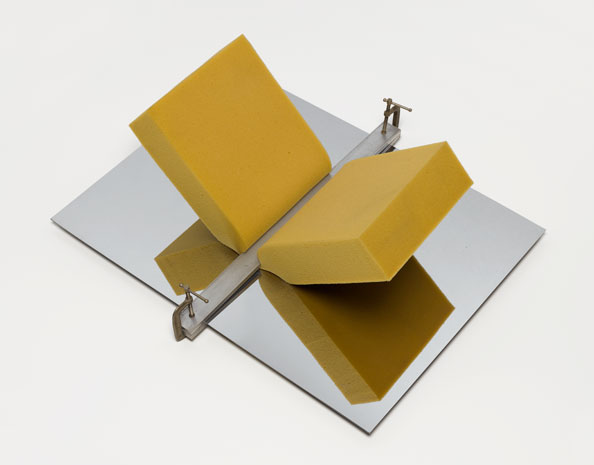Michael Snow: Objects of Vision
July 18, 2012 – March 13, 2013
Art Gallery of Ontario
“In my work I’m always a sculptor,” says Michael Snow. This is a rather unexpected comment coming from an artist whose extensive oeuvre spanning six decades includes painting, sculpture, film, photography, and music. But a key link between his works in various media is their quality of unfolding in time as they interact with the viewer’s perception and position. The fourteen sculptures that make up Snow’s current retrospective at the AGO, aptly titled Objects of Vision, are of no exception.
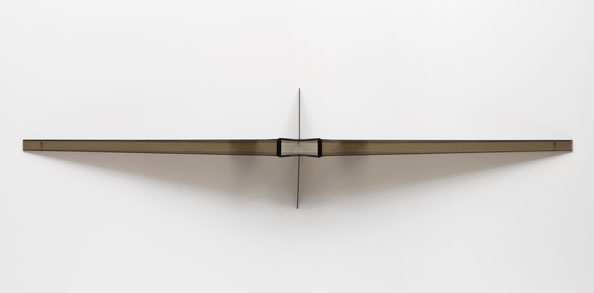 Michael Snow (Canadian, born 1928), Zone, 1982, plexiglass, rubber, 57.7 x 36.5 x 298.0 cm. AGO, purchase with funds from an anonymous donor, 2001 (2001/21). © Michael Snow 2012
Michael Snow (Canadian, born 1928), Zone, 1982, plexiglass, rubber, 57.7 x 36.5 x 298.0 cm. AGO, purchase with funds from an anonymous donor, 2001 (2001/21). © Michael Snow 2012
Born in Toronto, Snow relocated to New York City in 1962. Abstract Expressionism had by this time become ubiquitous and hegemonic, and resistance to its spiritualizing and mystifying tendency was shown by a generation of younger artists. Reified as Minimalism by 1968, this aesthetic shift emphasized the role of the viewer’s perception in the sculptural experience. Robert Morris, a key figure within Minimalism, wrote that “the object is but one of the terms in the newer aesthetic,” operating within a “function of space, light, and the viewer’s field of vision.”
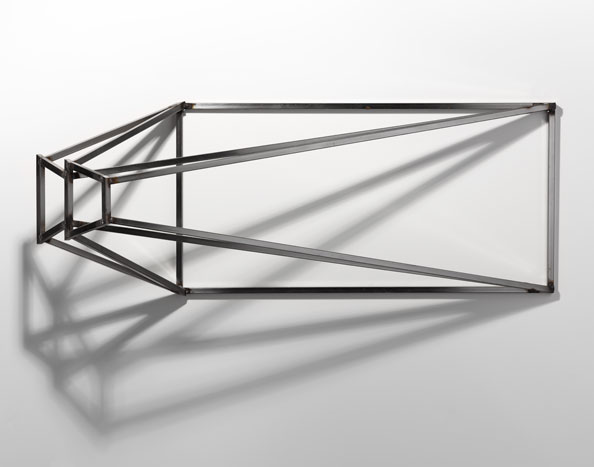 Michael Snow (Canadian, born 1928), Sighting, 1982, aluminum 38.5 x 102.0 x 32.5 cm. AGO, gift of Michael Snow, Toronto, 2001 (2001/206) © Michael Snow 2012
Michael Snow (Canadian, born 1928), Sighting, 1982, aluminum 38.5 x 102.0 x 32.5 cm. AGO, gift of Michael Snow, Toronto, 2001 (2001/206) © Michael Snow 2012
Snow’s sculptures from this period in New York were formed very much out of this cultural milieu. 1968’s Sighting is a rectangular work with a diagonal slot, which functions as a viewfinder that crops a section of the space beyond and incorporates it into the sculptural work. The image within the frame changes as the viewer shifts positions, such that the act of looking becomes involved in the composition and constant re-composition of the work.
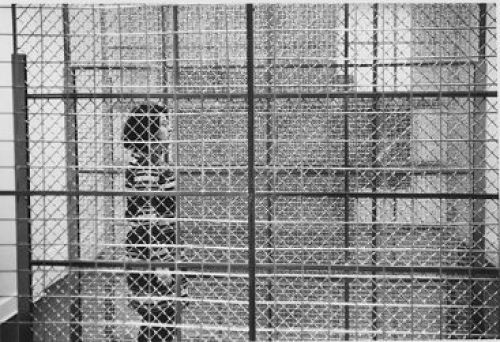 Michael Snow (Canadian, born 1928), Blind (with Joyce Wieland), 1968, steel and aluminum, 246.4 x 245.7 x 246.4 cm. National Gallery of Canada, purchase, 1969. © Michael Snow 2012
Michael Snow (Canadian, born 1928), Blind (with Joyce Wieland), 1968, steel and aluminum, 246.4 x 245.7 x 246.4 cm. National Gallery of Canada, purchase, 1969. © Michael Snow 2012
Blind is a work from the same year made of four parallel mesh screens of increasing gauge of opening. The viewer is encouraged to walk through the space between the meshes and is made aware of occupying the same space as the sculpture. If the slot of Sighting emulates a camera’s viewfinder, Blind calls for the viewer’s eyes to zoom in and out like a camera lens. The superimposed mesh screens “establish different focal planes” that prompt the viewer’s eyes to zoom back and forth from one plane to another.
Michael Snow (Canadian, born 1928), 432101234, 1969, Chromed steel, aluminum and polyurethane foam, 27.6 x 59.2 x 68.0 cm. AGO, gift of Michael Snow, Toronto, 2001 (2001/202) © Michael Snow 2012
Snow’s sculptural practice also embodies Minimalism’s other key trope of truth to materials and transparency of construction, an aesthetic of materiality that finds its roots in Constructivism. Departing from the phenomenological investigation of Blind, the 1969 sculptures Membrane and 432101234 call forth the viewer’s attention toward the materials (rubber and polyurethane foam, respectively) and the procedure behind its formal presentation.
 Michael Snow (Canadian, born 1928), with Transformer, 1982, wood, varnish, rope and cardboard, height adjustable x 490.0 x 12.0 cm tapering to a point. AGO, purchase with funds from an anonymous donor, 2001 (2001/120). © Michael Snow 2012
Michael Snow (Canadian, born 1928), with Transformer, 1982, wood, varnish, rope and cardboard, height adjustable x 490.0 x 12.0 cm tapering to a point. AGO, purchase with funds from an anonymous donor, 2001 (2001/120). © Michael Snow 2012
In the exhibition catalogue, Curator Georgiana Uhlyarik commented that Transformer (1982) and Core (1982-1984) are the anchors of the exhibition. Both works possess a sense of drama that makes them stand out from the others. Even more, both are demonstrative of the two Minimalist tendencies evident in Snow’s earlier sculptural work – to involve the viewer’s vision in a participatory manner and to present material and procedural clarity. The imposing Transformer is composed of a narrow, five-meter-long tree trunk that hangs horizontally by a rope. The wood is whittled on one end to a sharp point, which persuasively directs our gaze along the wood and past the tip into space, away from itself. Yet, the work’s exposed materials and clear articulation of parts also function to direct attention to itself, toward its materiality and process. Likewise, the pillar-like Core makes manifest in the viewing of the work the materiality of ceramic from which it is made and the process of its production on a pottery wheel. The concentric piece entices the viewer to walk around it, but towering two meters high and despite its title, the core is impossible to access with the eye.
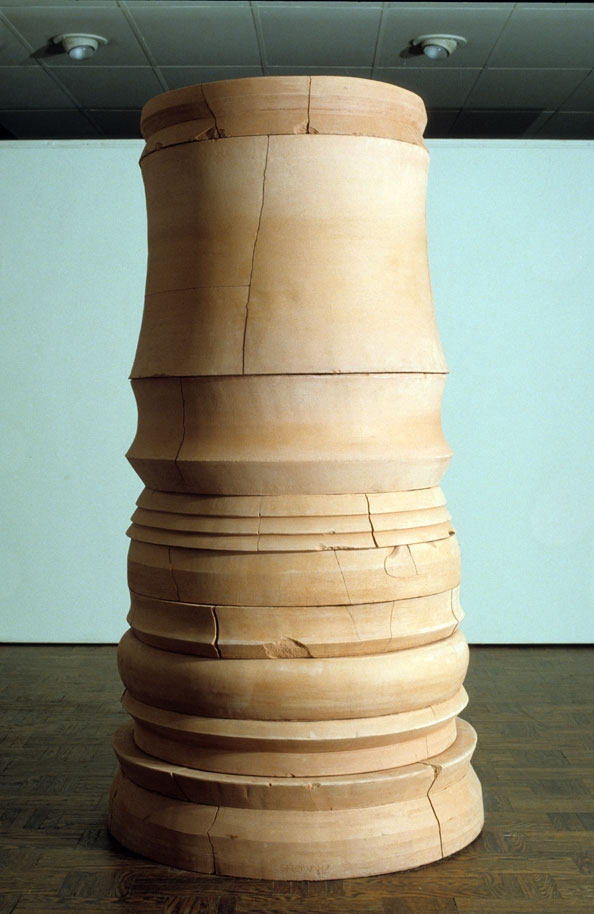 Michael Snow (Canadian, born 1928), Core, 1982-84, unglazed ceramics, 206.5 x 82.o cm (10 sections). AGO, Collection of Canada Council for the Arts, Art Bank © Michael Snow 2012
Michael Snow (Canadian, born 1928), Core, 1982-84, unglazed ceramics, 206.5 x 82.o cm (10 sections). AGO, Collection of Canada Council for the Arts, Art Bank © Michael Snow 2012
Transformer and Core powerfully attract and play with the viewer’s attention. This playful interaction between the object and the perceiver is present in the experience of all of the sculptures in the show. Snow’s objects deftly direct the viewer’s eyes and body, providing an entry-point for engaging with his art for visitors of all levels of visual literacy. By heightening our awareness of looking and of being in space, the fourteen sculptures successfully and playfully keep the viewer active and engaged.
by Amy Luo

